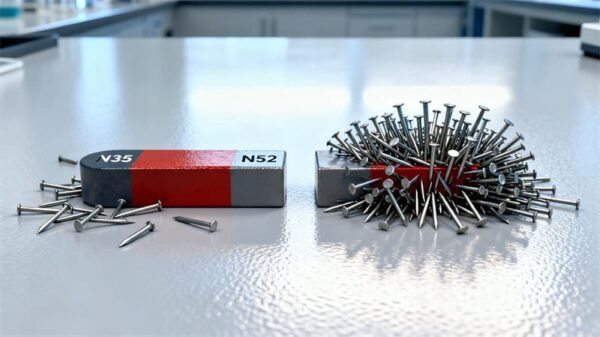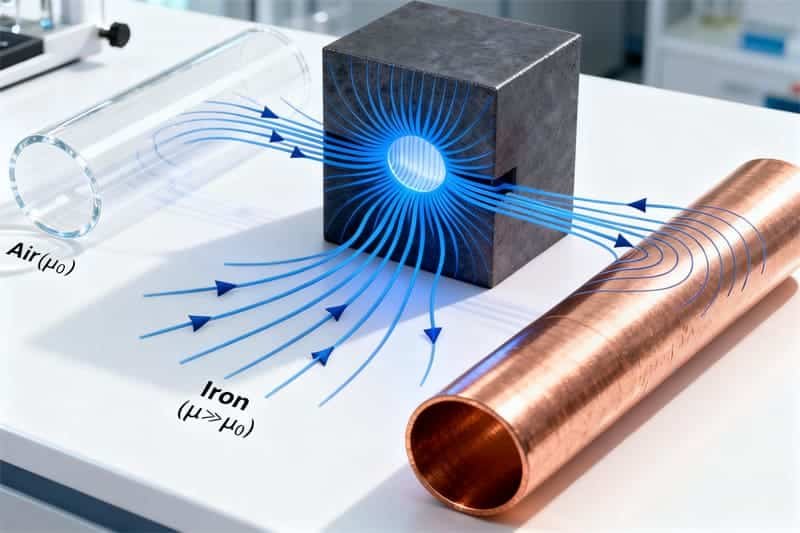
What is Magnetic Permeability
The concept of magnetic permeability indicates the rate at which a material permits magnetic field lines to pass through it. In less technical terms, it is a measure of how easily a material can conduct magnetism through it, similar to electrical conductivity being a measure of how easily electricity can conduct.
This fact describes why such materials as iron become powerful magnets, whereas wood or plastic do not. Highly permeable materials are able to concentrate the magnetic lines, which is valuable in motors, transformers, and inductors.
Magnetic Permeability Definition
The extent to which a material carries a magnetic field in it is called magnetic permeability. It narrates the response of the material to the application of a magnetic field.
Consider magnetic lines as water in a pipe; a highly permeable material resembles a broad pipe that allows magnetism to pass easily. The permeability representation is m (mu), and it is a significant parameter in the magnetic calculations.
Magnetic Permeability of Free Space
Magnetic permeability of free space, commonly referred to as μ₀ (mu-naught), is a property of magnetism in the vacuum. It has a constant value of 4π × 10⁻⁷ H/m (henry per meter).
This can be used to draw a comparison of the magnetic behavior of other materials. In the case of relative permeability, this is always due to being measured relative to μ₀.
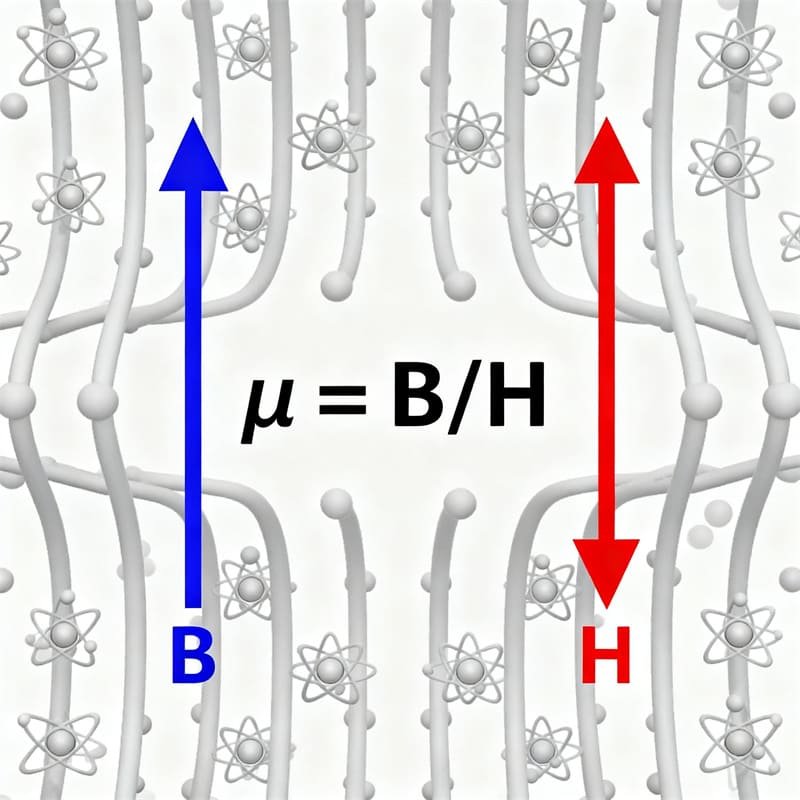
Relationship between B and H; permeability μ definition
Permeability connects two important terms in magnetism, magnetic flux density (B) and magnetic field strength (H), by the equation:
B = μH
In this case, B represents the overall magnetic field within the material, H is the applied field, and μ is the response strength of the material.
In case m is high, the material is easily magnetized; in case it is low, it is not easily magnetized.
Microscopic vs. macroscopic view; incremental permeability
At the microscopic scale, magnetic permeability is determined by the alignment of small atomic magnets (dipoles) with an external field. In substances such as iron, the atoms are oriented in a large number, which makes them very highly permeable.
At the macroscopic scale, permeability is a term used to describe the overall behavior of the material as an entity and can vary with the strength of the field, temperature, or frequency.
The small change in magnetic flux by the small change in the applied field is the incremental permeability. It can also be helpful in the investigation of the behavior of materials to alternating or variable magnetic fields, including transformers and electronic circuits.
Magnetic Permeability Formula
To study magnetic permeability in real life, we use formulas. These help calculate how magnetic fields act inside different materials. By using these equations, engineers can compare materials, design better magnetic devices, and predict how well a substance can carry magnetism.
Symbols/Units and Variables
In magnetic equations, three main symbols are used: B, H, and μ.
- B stands for magnetic flux density, measured in tesla (T). It shows the total magnetic field inside the material.
- H represents magnetic field strength, measured in amperes per meter (A/m). It shows the intensity of the applied magnetic field.
- μ is the magnetic permeability, showing how much magnetic flux is produced inside the material for a given applied field.
Together, they form the basic equation B = μH.
Unit of Magnetic Permeability
The standard SI unit of magnetic permeability is the henry per meter (H/m). It can also be expressed as tesla meter per ampere (T·m/A) because 1 henry equals 1 tesla meter per ampere.
This unit describes how much magnetic field (in tesla) is generated for a given current strength per meter of material.
Dimensional Formula
The dimensional formula of magnetic permeability can be derived from the equation B = μH.
We know:
- B has dimensions [M¹ L⁰ T⁻² I⁻¹]
- H has dimensions [I L⁻¹]
Therefore,
μ = B / H = [M¹ L¹ T⁻² I⁻²]
Hence, the dimensional formula of magnetic permeability is M¹ L¹ T⁻² I⁻², which represents its dependence on mass, length, time, and electric current.
Relative Magnetic Permeability Units
Relative magnetic permeability (μᵣ) is a dimensionless quantity. It represents the ratio between the material’s permeability (μ) and the permeability of free space (μ₀):
μᵣ = μ / μ₀
Since both μ and μ₀ have the same units, their ratio has no unit. This makes μᵣ a pure number used for easy material comparison.
Relative Permeability and Magnetic Susceptibility
Relative permeability and magnetic susceptibility describe how materials react to magnetic fields. Permeability shows how easily a magnetic field passes through a material, while susceptibility shows how strongly the material becomes magnetized. Together, they explain the magnetic behavior of different substances.
μᵣ = μ/μ₀; χₘ = μᵣ − 1
Relative permeability (μᵣ) is the ratio of a material’s permeability (μ) to the permeability of free space (μ₀). It tells how much better or worse a material carries magnetic flux compared to a vacuum.
Magnetic susceptibility (χₘ) measures how much magnetization is produced inside the material. They’re linked by χₘ = μᵣ − 1, meaning higher μᵣ gives higher χₘ.
Magnetic Susceptibility
Magnetic susceptibility (χₘ) shows how easily a material becomes magnetized. If χₘ is positive, the material is attracted to magnets (like iron — paramagnetic or ferromagnetic). If χₘ is negative, it’s slightly repelled (diamagnetic). This helps identify how atoms align with a magnetic field.
Relation to Susceptibility and μ₀
Permeability and susceptibility are linked through the formula μ = μ₀(1 + χₘ). It shows that total permeability depends on both the vacuum’s permeability and the material’s susceptibility. When χₘ increases, μ also increases — meaning the material supports a stronger magnetic field.
Relation Between χ and μᵣ
The simple link between them is μᵣ = 1 + χₘ.
If χₘ = 0, then μᵣ = 1 (like air or vacuum).
Ferromagnetic materials have high χₘ and very large μᵣ, while diamagnetic materials have small negative χₘ and μᵣ just below 1. This relationship helps classify materials by their magnetic behavior.
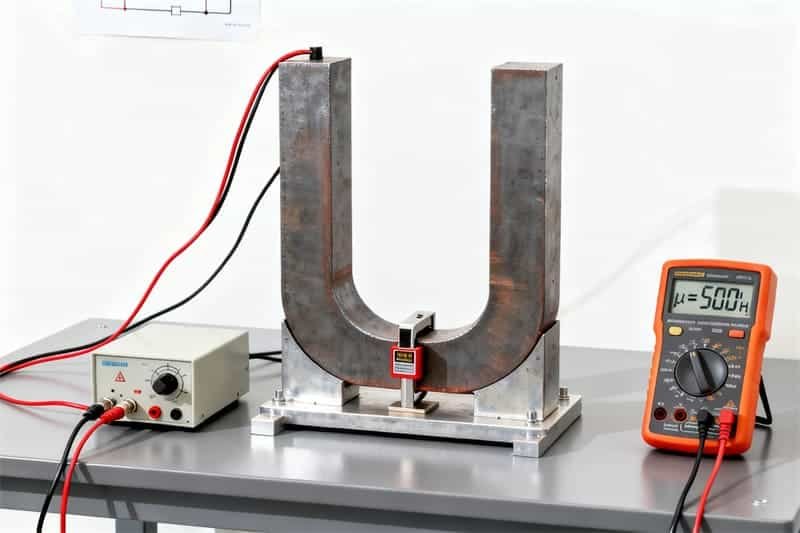
Types of Magnetic Permeability
Magnetic permeability is not a constant value. It varies depending on the material and the field of application, strength, and other conditions such as temperature or frequency. Various classes of permeability are defined below, which describe the behavior of materials in moving through certain magnetic fields or signal conditions in the steady and alternating magnetic fields.
Absolute Permeability (μ)
The actual permeability of a material in henry per meter (H/m) is known as the absolute permeability (μ). It is the sum of all the conducting abilities of that material to the magnetic flux. Absolute permeability contains the effect of atomic structure as well as external field conditions of the material.
It is useful for the base of calculation, and then compared with free space or relative measures.
Relative Permeability (μᵣ)
Relative permeability (μᵣ) is a ratio of the permeability of a material to the permeability of free space. It is the ratio of the amount of magnetic field that a substance can carry than what the vacuum can carry.
As an example, when μᵣ equals 1000 for soft iron, then it means soft iron would be able to conduct magnetic flux 1000 times better than air.
Amplitude, maximum, initial, incremental, reversible, complex
The different types of permeability help scientists understand how materials behave under different environmental conditions.
Amplitude permeability is the value that appears when the magnetic field undergoes sinusoidal changes.
Initial permeability – the permeability at very low magnetic fields.
Maximum permeability is the topmost value measured before the materials become saturated.
Incremental permeability is the small-signal permeability around a specific bias point.
Reversible permeability value is the behavior of materials in cases where the direction of the magnetic fields entirely reverses.
The complex permeability model is applicable in alternating fields that have power losses and phase shifts.
Types of Magnetic Materials
The magnetic materials are arranged according to their responses to the magnetic field by scientists. The materials exhibit varying resistance to the magnetic field, with some materials being highly resistant and others having weak resistance, and others being highly attractive. Understanding of permeability and susceptibility is used in the selection of suitable materials for their magnetic and electronic work, depending on the behavior of the materials.
Categories of Magnetic Permeability
Scientists group magnetic materials into three major categories. Such as:

Ferromagnetic materials
The ferromagnetic materials exhibit the greatest degree of permeability since it is strongly attracted to a magnetic field.
The atomic dipoles in such materials are parallel to each other and thus lead to a vastly large value of permeability, thousands of times larger than free space values.
These materials are used in motor construction and transformer applications and magnetic core development, but their permeability characteristics decrease with increasing temperature or an increasing magnetic field. The materials become non-magnetic at temperatures beyond the Curie point.
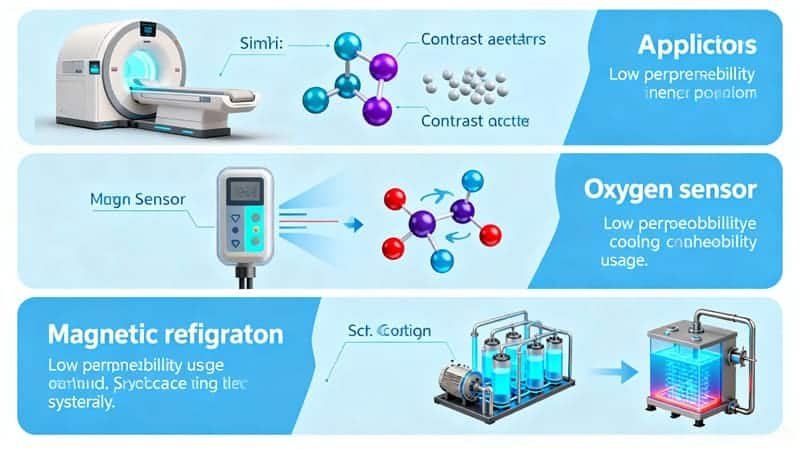
Paramagnetic Materials
Paramagnetic materials have a small, positive susceptibility and a relative permeability slightly greater than one. Examples include aluminum, platinum, and magnesium. The materials exhibit a certain attraction to magnets, but the attraction is lost on the removal of the magnetic field.
The materials have a scientific research application and can work in a weak magnetic field environment.
Diamagnetic Materials
The diamagnetic materials, such as copper and gold, and bismuth, are pushed off by the magnetic fields. These materials’ magnetic moments of electrons cause a weak repelling effect as they resist the external magnetic field.
Complex Permeability
When there are some time-dependent changes in the magnetic fields applied to materials, the permeability becomes complicated in the cases of alternating currents or microwave functions. Storage or loss of energy under an alternating magnetic field is given by the two components of complex permeability, which encompass the actual and imaginary components.
μ′ and μ″; loss tangent tan δ = μ″/μ′
In complex permeability, μ′ (mu prime) represents the real part, showing how much magnetic energy is stored, while μ″ (mu double prime) represents the imaginary part, showing how much energy is lost as heat.
The loss tangent (tan δ = μ″ / μ′) indicates how efficiently a magnetic material operates at alternating frequencies. A lower tan δ means fewer losses and better performance.
This concept is critical in designing materials for high-frequency transformers, antennas, and shielding, where both energy storage and loss matter.
Magnetic Hysteresis
Magnetic hysteresis refers to the lag between changes in magnetic field power and the resulting magnetization of a material. It shows that permeability isn’t regular, however depends on magnetic records, how the material changes into previously magnetized or demagnetized during repeated magnetic cycles.
Permeability Changes with B–H Loop
Within the B-H curve (loop of magnetic hysteresis), permeability remains constant with an increase and a decrease in magnetization. First, the permeability increases violently with the alignment of atomic dipoles with the sphere.
Once the field reaches its saturation point, additional increasing field strength makes insignificant additional magnetization. At the reversal point, it is not completely reversed and therefore, hysteresis loss occurs.
This loop allows the determination of the efficiency of cycles of magnetic substances to store and release energy.
Saturation and Core Materials
When a magnetic core has become saturated, all magnetic domains have aligned, and the permeability reduces greatly. At this stage, the material is not able to hold more magnetic flux.
The major materials used as core, such as silicon metal, ferrite, and iron alloys, are chosen entirely with respect to their ability to handle saturation effectively.
It is important to maintain high permeability below saturation in transformers, inductors, and other electromagnetic devices to ensure that clean magnets are operating and the least losses are being incurred.
Factors affecting Permeability
The magnetic permeability is not fixed but varies depending on the temperature, material structure, impurities, and power of the magnetic field. The awareness of the said factors helps in creating magnetic and electronic devices.
Temperature, Microstructure, Impurities
The high temperature causes the magnetic alignment to be perturbed by atomic vibrations, and this lowers the permeability.
The microstructure (such as grain size and crystal orientation) can also be critical; finer grains oftentimes will yield better results.
Most of the impurities, such as carbon or oxygen, interfere with the motion of the domains; hence, magnetic alloys are heat-treated and purified to balance.
Nonlinearity; saturation effects
In high magnetic fields, the domains align, which leads to nonlinear permeability behaviour. The material becomes resistant to permeability after which its value reduces swiftly. Transformers are designed based on saturation prevention, which prevents the loss of energy and the degradation of the signal.
Magnetic Permeability can Change
Magnetic permeability of the materials is subject to change with time due to stress application and various magnetization cycles, and mechanical pressure. The magnetic alignment of the domains undergoes slight variation, due to which magnetic materials require special treatment to maintain their homogeneous properties.
Example of Magnetic Permeability in Mild Steel
Mild steel has high magnetic permeability since its relative permeability lies between 2000 and 5000, which allows the magnetic lines to pass through the material thousands of times compared to air. The material has been used as a great substitute for transformer cores and electromagnets due to its high permeability.
Example of Magnetic Permeability in Wood
The values of relative permeability of wood are in the range of 1, meaning it does not pull or push away the magnetic fields. The material is a nonmagnetic base on scientific experiments that do not to interfere with a magnetic field.
Applications of High Permeability Materials
The functioning of electrical and electronic systems also relies on high magnetic permeable materials. These materials minimize energy waste, enhance performance, and stabilize magnetic circuits in transformers, motors, and shielding devices that have to work under heavy or variable magnetic conditions.
Transformers and Inductors
Transformers and inductors have high-permeability cores constructed of silicon steel or ferrite, which permits easy transmission of magnetic flux. The system has improved energy transfer with low power loss and leakages of magnetic fields. A suitable choice of core materials makes it possible to provide stable and efficient work in power supply systems and circuits of signal transmission.
Magnetic Storage
Hard drives and tapes are magnetic storage devices that store digital data using materials with highly regulated permeability. Binary information is represented by the magnetic orientation of small regions. The material facilitates the effective writing and reading of the data, besides expanding storage space.
Electromagnetic Shielding
Electromagnetic shielding is done with high-permeability material like mu-metal. The magnetic field lines are absorbed and redirected by them, therefore, avoiding interference with sensitive electronics. The material shields medical equipment and communication systems, and laboratory equipment against electromagnetic interference.
Extraneous Magnetic Fields
High-permeability materials function as protective barriers that redirect magnetic fields toward safe areas when strong or uncontrolled magnetic fields exist. The materials protect MRI facilities and aerospace operations, and precision scientific equipment from interference while ensuring operational precision and safety.
Conclusion
Magnetic permeability is one of the main properties that describes the behavior of materials in the presence of a magnetic field. It bridges atom-level interactions with large-signal magnetic performance, which leads to an understanding of the different kinds of materials in the context of magnetic fields. To put it more simply, some materials will enhance the magnetic field while others will weaken it. The study of permeability is very helpful in grasping the behavior of magnetic domains and their role in determining the efficiency of magnetic devices.
The ability to control permeability is one of the most important factors for the creation of trustworthy and energy-saving systems in modern-day technology. By knowing how temperature, impurities, and saturation affect permeability, engineers can come up with magnetic components that are not only smarter but also more stable for real-world applications.
FAQ
Is High Magnetic Permeability Good?
High magnetic permeability values create positive effects in most situations. The material enables better magnetic flux transmission, which leads to improved operational efficiency in transformers and motors, and inductors.

I’m Ben, with over 10 years in the permanent magnet industry. Since 2019, I’ve been with Osenc, specializing in custom NdFeB magnet shapes, magnetic accessories, and assemblies. Leveraging deep magnetic expertise and trusted factory resources, we offer one-stop solutions—from material selection and design to testing and production—streamlining communication, accelerating development, and ensuring quality while reducing costs through flexible resource integration.


